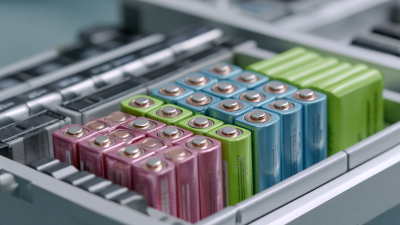Exploring the Future of Battery Technology Innovations Strategies to Enhance Performance and Sustainability
As the demand for sustainable energy solutions continues to surge, the battery industry stands at a pivotal moment, with innovations poised to reshape the landscape of energy storage and consumption. According to a recent report by the International Energy Agency (IEA), the global battery market is projected to reach $250 billion by 2025, driven by advancements in electric vehicles, renewable energy integration, and consumer electronics.

The rapid development of battery technologies, including lithium-ion, solid-state, and next-generation batteries, is crucial for enhancing performance, longevity, and sustainability. Strategies that focus on increasing energy density and recyclability of batteries not only promise to improve efficiency but also play a significant role in addressing environmental concerns.
As we explore the future of battery technologies, it is essential to identify innovative strategies that will support the transition towards a carbon-neutral economy while meeting the growing energy demands of various sectors.
Innovative Materials: Unlocking Next-Gen Battery Performance and Longevity
Innovative materials play a crucial role in shaping the future of battery technology, particularly as researchers explore enhancements in performance and sustainability. Recent advancements in silicon anodes demonstrate significant improvements in lithium-ion batteries, paving the way for next-generation superbatteries. These innovations are vital as the demand for efficient energy storage escalates, primarily driven by the rapid growth of electric vehicles and renewable energy systems. Researchers are now focusing on hybrid anode designs, such as silicon-tin sulphide, to achieve higher capacity and longevity in energy storage applications.

Another promising development is the emergence of alternatives like zinc-iodine batteries, which combine high capacity with long-term durability. Breakthroughs in aqueous battery systems have also been reported, highlighting innovative materials that can increase lifespan significantly by minimizing detrimental effects from free water molecules. Furthermore, the incorporation of graphene in battery technology is revolutionizing energy storage by offering faster charging capabilities and addressing scalability challenges. These innovations mark a transition towards more sustainable and high-performance battery solutions, indicating a bright future for energy storage systems.
Smart Battery Management Systems: Enhancing Efficiency and Safety
The evolution of smart battery management systems (BMS) is crucial for enhancing the efficiency and safety of electric vehicles (EVs). With the intelligent battery sensor market projected to reach approximately USD 18.59 billion, the demand for advanced monitoring technologies is skyrocketing. This growth is driven largely by the increased adoption of electric vehicles and the implementation of stringent emission regulations. As a result, the integration of IoT, blockchain, and machine learning into smart BMS can optimize battery performance, prolong operational longevity, and ensure the safety of battery systems.
Moreover, the push towards digitalization and smart energy infrastructure is facilitating significant market growth. Advanced BMS solutions are becoming pivotal in managing the challenges of electrification in mobility, particularly in next-generation light electric vehicles. Companies are leveraging AI technologies not only for safety monitoring and energy trading but also to revolutionize battery storage systems. This convergence of smart technology and battery management is set to transform the landscape of energy usage, making EVs more efficient and sustainable for future transportation needs.
Sustainable Production Techniques: Reducing Environmental Impact in Battery Manufacturing
The growing demand for sustainable battery solutions is driving innovations in manufacturing techniques aimed at reducing environmental impacts. Recent collaborations and funding initiatives emphasize this shift towards green production practices. For instance, the European Commission has allocated €852 million to support six battery production projects, underlining a commitment to sustainable practices that minimize ecological footprints. Additionally, innovations in raw material sourcing are emerging, with the sustainable battery raw materials market projected to expand significantly by 2034, focusing on eco-friendly and ethically sourced materials such as lithium and nickel.

Tips: When exploring sustainable battery manufacturing, consider the importance of adopting water-based recycling techniques, which can reduce carbon footprints by up to 30%. Companies are also investing in green lithium extraction processes that notably lower water usage and emissions, contributing to broader environmental goals.
The challenges of battery production can be met with an emphasis on recycling and efficient resource utilization. Studies on the life cycle of lithium-ion batteries highlight opportunities to optimize supply chains, not just for initial production but also for recycling processes. Engaging in these innovations will be crucial for companies aiming to align with both sustainability goals and the rapidly evolving demands of the electric vehicle market.
Emerging Battery Technologies: Opportunities and Challenges for Future Applications
Emerging battery technologies are at the forefront of transforming energy storage solutions, offering vast opportunities while also presenting unique challenges for future applications. Innovations such as solid-state batteries, lithium-sulfur cells, and flow batteries are pushing the boundaries of energy density, safety, and longevity. Solid-state batteries, for instance, promise increased energy capacity and reduced fire risk, positioning themselves as a game-changer for electric vehicles and portable electronics. Similarly, lithium-sulfur batteries are gaining attention for their potential to deliver higher energy density at a lower cost, making them a compelling choice for large-scale energy storage.
However, alongside these opportunities lie significant hurdles that must be navigated. Manufacturing processes for advanced batteries often require rare materials, raising concerns about sustainability and supply chain stability. Additionally, achieving scalability while maintaining cost-effectiveness continues to be a major challenge. The integration of these technologies into existing infrastructures must be carefully planned to ensure compatibility and efficiency. Balancing innovation with practicality will be crucial for the successful deployment of these emerging battery solutions in a rapidly evolving energy landscape.
Exploring the Future of Battery Technology Innovations Strategies to Enhance Performance and Sustainability
| Battery Technology | Energy Density (Wh/kg) | Cycle Life (Cycles) | Charging Time (Hours) | Sustainability Index | Applications |
|---|---|---|---|---|---|
| Lithium-ion | 150-250 | 500-1500 | 1-3 | Moderate | Consumer electronics, EVs |
| Solid-state | 300-500 | 2000+ | 0.5-1 | High | Electric vehicles, grid storage |
| Lithium-sulfur | 500-600 | 300-500 | 3-6 | Moderate | Aerospace, electric vehicles |
| Flow batteries | 20-40 | 5000+ | 4-10 | High | Grid energy storage, renewable energy integration |
Collaborative Innovations: Driving Industry Partnerships for Sustainable Solutions
The landscape of battery technology is rapidly evolving, and collaborative innovations are becoming pivotal in driving sustainable solutions across industries. Recent partnerships, such as those focused on next-generation enzyme and polymer innovations, highlight how cross-sector collaboration can accelerate the development of more efficient and environmentally friendly battery systems. By pooling expertise from various fields, companies can share knowledge and resources, fostering breakthroughs that would be challenging to achieve independently.
Moreover, international collaborations, such as those between India and the Netherlands to advance green hydrogen innovation, illustrate the importance of global partnerships in addressing sustainability challenges. These alliances not only promote technological advancements but also create a framework for sharing best practices and aligning strategies towards common sustainability goals. As organizations like universities and research institutions engage with the industry, the potential for innovative solutions to emerge is significantly increased, ultimately leading to enhanced performance in battery technologies that are both efficient and sustainable.
Exploring Battery Technology Innovations
Related Posts
-

Exploring the Benefits and Applications of Sealed Lead Acid Batteries in Modern Technology
-

Understanding the Benefits of Lawn Battery Technology for Sustainable Gardening Practices
-

Essential Guide to Choosing the Right Lawn Tractor Battery for Optimal Performance
-

Revolutionizing Yard Care: How Lawn Batteries are Leading the Charge Towards Eco-Friendly Landscaping
-

Batteries Delivered Revolutionizing Supply Chains at the 138th China Import and Export Fair 2025
-

Unleashing the Power: Exploring the Future of Eco-Friendly Batteries & More Innovations
